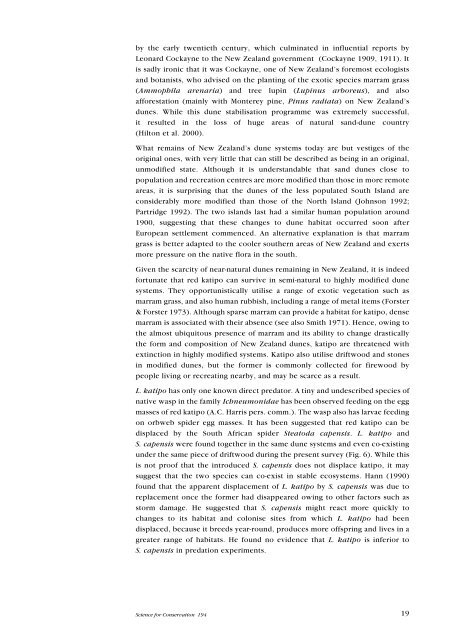Conservation status of the New Zealand red katipo spider ...
Conservation status of the New Zealand red katipo spider ...
Conservation status of the New Zealand red katipo spider ...
You also want an ePaper? Increase the reach of your titles
YUMPU automatically turns print PDFs into web optimized ePapers that Google loves.
y <strong>the</strong> early twentieth century, which culminated in influential reports by<br />
Leonard Cockayne to <strong>the</strong> <strong>New</strong> <strong>Zealand</strong> government (Cockayne 1909, 1911). It<br />
is sadly ironic that it was Cockayne, one <strong>of</strong> <strong>New</strong> <strong>Zealand</strong>’s foremost ecologists<br />
and botanists, who advised on <strong>the</strong> planting <strong>of</strong> <strong>the</strong> exotic species marram grass<br />
(Ammophila arenaria) and tree lupin (Lupinus arboreus), and also<br />
afforestation (mainly with Monterey pine, Pinus radiata) on <strong>New</strong> <strong>Zealand</strong>’s<br />
dunes. While this dune stabilisation programme was extremely successful,<br />
it resulted in <strong>the</strong> loss <strong>of</strong> huge areas <strong>of</strong> natural sand-dune country<br />
(Hilton et al. 2000).<br />
What remains <strong>of</strong> <strong>New</strong> <strong>Zealand</strong>’s dune systems today are but vestiges <strong>of</strong> <strong>the</strong><br />
original ones, with very little that can still be described as being in an original,<br />
unmodified state. Although it is understandable that sand dunes close to<br />
population and recreation centres are more modified than those in more remote<br />
areas, it is surprising that <strong>the</strong> dunes <strong>of</strong> <strong>the</strong> less populated South Island are<br />
considerably more modified than those <strong>of</strong> <strong>the</strong> North Island (Johnson 1992;<br />
Partridge 1992). The two islands last had a similar human population around<br />
1900, suggesting that <strong>the</strong>se changes to dune habitat occur<strong>red</strong> soon after<br />
European settlement commenced. An alternative explanation is that marram<br />
grass is better adapted to <strong>the</strong> cooler sou<strong>the</strong>rn areas <strong>of</strong> <strong>New</strong> <strong>Zealand</strong> and exerts<br />
more pressure on <strong>the</strong> native flora in <strong>the</strong> south.<br />
Given <strong>the</strong> scarcity <strong>of</strong> near-natural dunes remaining in <strong>New</strong> <strong>Zealand</strong>, it is indeed<br />
fortunate that <strong>red</strong> <strong>katipo</strong> can survive in semi-natural to highly modified dune<br />
systems. They opportunistically utilise a range <strong>of</strong> exotic vegetation such as<br />
marram grass, and also human rubbish, including a range <strong>of</strong> metal items (Forster<br />
& Forster 1973). Although sparse marram can provide a habitat for <strong>katipo</strong>, dense<br />
marram is associated with <strong>the</strong>ir absence (see also Smith 1971). Hence, owing to<br />
<strong>the</strong> almost ubiquitous presence <strong>of</strong> marram and its ability to change drastically<br />
<strong>the</strong> form and composition <strong>of</strong> <strong>New</strong> <strong>Zealand</strong> dunes, <strong>katipo</strong> are threatened with<br />
extinction in highly modified systems. Katipo also utilise driftwood and stones<br />
in modified dunes, but <strong>the</strong> former is commonly collected for firewood by<br />
people living or recreating nearby, and may be scarce as a result.<br />
L. <strong>katipo</strong> has only one known direct p<strong>red</strong>ator. A tiny and undescribed species <strong>of</strong><br />
native wasp in <strong>the</strong> family Ichneumonidae has been observed feeding on <strong>the</strong> egg<br />
masses <strong>of</strong> <strong>red</strong> <strong>katipo</strong> (A.C. Harris pers. comm.). The wasp also has larvae feeding<br />
on orbweb <strong>spider</strong> egg masses. It has been suggested that <strong>red</strong> <strong>katipo</strong> can be<br />
displaced by <strong>the</strong> South African <strong>spider</strong> Steatoda capensis. L. <strong>katipo</strong> and<br />
S. capensis were found toge<strong>the</strong>r in <strong>the</strong> same dune systems and even co-existing<br />
under <strong>the</strong> same piece <strong>of</strong> driftwood during <strong>the</strong> present survey (Fig. 6). While this<br />
is not pro<strong>of</strong> that <strong>the</strong> introduced S. capensis does not displace <strong>katipo</strong>, it may<br />
suggest that <strong>the</strong> two species can co-exist in stable ecosystems. Hann (1990)<br />
found that <strong>the</strong> apparent displacement <strong>of</strong> L. <strong>katipo</strong> by S. capensis was due to<br />
replacement once <strong>the</strong> former had disappea<strong>red</strong> owing to o<strong>the</strong>r factors such as<br />
storm damage. He suggested that S. capensis might react more quickly to<br />
changes to its habitat and colonise sites from which L. <strong>katipo</strong> had been<br />
displaced, because it breeds year-round, produces more <strong>of</strong>fspring and lives in a<br />
greater range <strong>of</strong> habitats. He found no evidence that L. <strong>katipo</strong> is inferior to<br />
S. capensis in p<strong>red</strong>ation experiments.<br />
Science for <strong>Conservation</strong> 194<br />
19

















